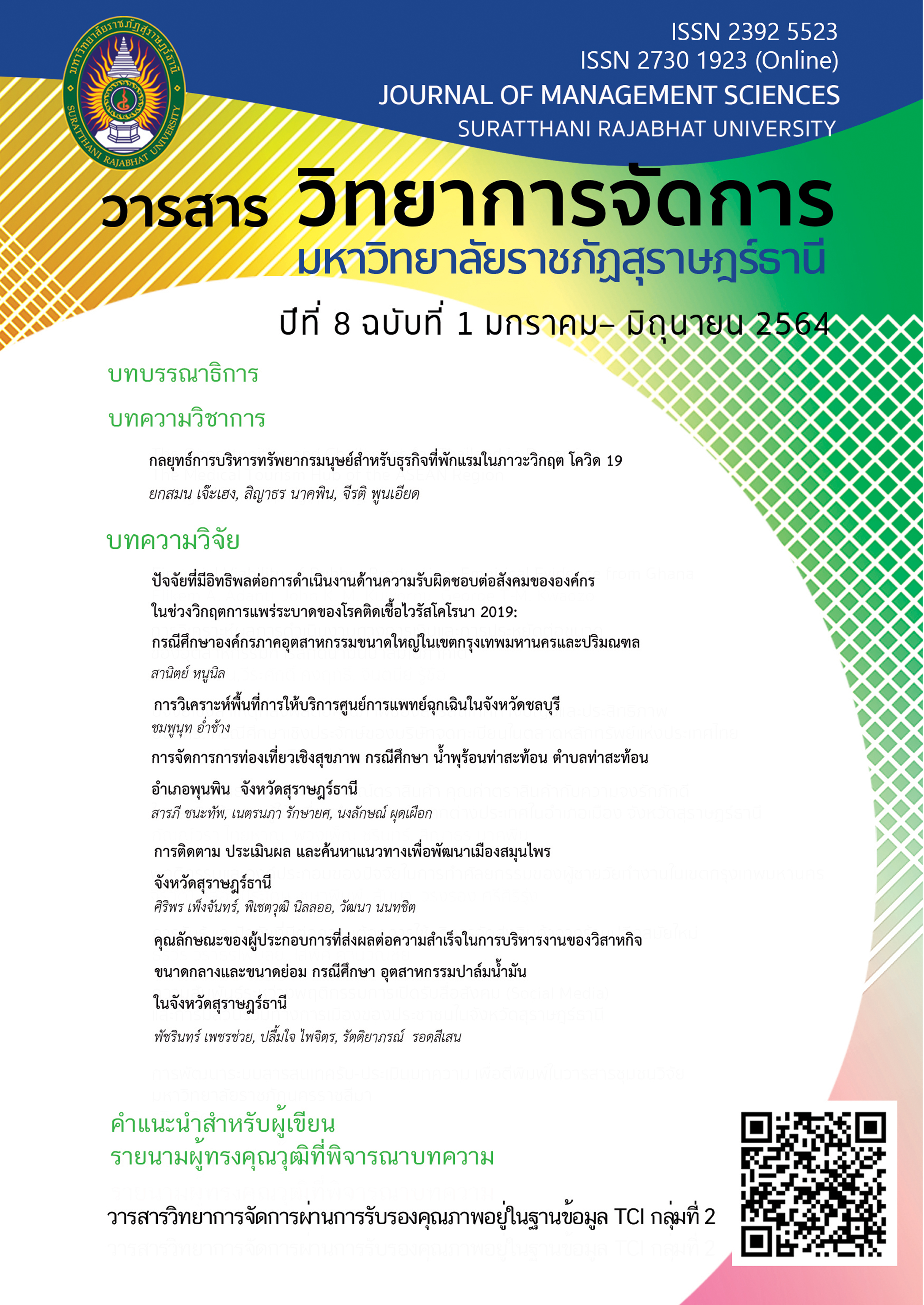Project Evaluation: Guidelines and Recommendations for the Development Of the Herbal City, Suratthani, Thailand
Main Article Content
Abstract
The objective of this study is to evaluate the project and to suggest the development by the CIPPOIST - MODEL. In evaluating the results, it is found that 1) the project context is necessary, clear, no duplication with the project, both in address and following, and the mission of the various departments responsible. 2) Regarding the inputs, it is found that the budget, duration, materials, activities, and goals, there is consistency between the operation areas. 3) In the process, it is found that the efficiency, effectiveness of the use of resources are most useful. Evaluation of the project process on the timing of the project plan. Method of operation And the performance of various activities 4) In terms of production, it is found that both quantitative and qualitative indicators project output by activity outcome resulting from project production which the impact of project operations, both positive and negative Have coverage and 5) Success factors found that the responsible person has to understand the situation to study basic information before implementing the project. The project management team or personnel responsible for small activities. Conducting detailed project studies in-depth analysis both in terms of basic factors and various environments as well, affecting the success of the project
Article Details
References
พิชิต ฤทธ์จรูญ. (2557). เทคนิคการประเมินโครงการ.พิมพ์ครั้งที่ 2 กรุงเทพฯ: เฮ้าส์อ๊อฟเคอร์มีสท์
ศิริชัย กาญจนวาสี. (2552). ทฤษฎีการประเมิน พิมพ์ครั้งที่ 7 กรุงเทพฯ: สำนักพิมพ์แห่งจุฬาลงกรณ์มหาวิทยาลัย.
สมหวัง พิธิยานุวัฒน์. (2553). วิธีวิทยาการประเมิน: ศาสตร์แห่งคุณค่า. พิมพ์ครั้งที่ 5 กรุงเทพฯ: สำนักพิมพ์แห่งจุฬาลงกรณ์มหาวิทยาลัย
สถาบันที่ปรึกษาเพื่อพัฒนาประสิทธิภาพในราชการ. (2559). การวิเคราะห์ประเมินผลโครงการด้านความปลอดภัยในการใช้รถใช้ถนน. กรุงเทพฯ: กรมการขนส่งทางบก.
Ebel, R.L. And Frisbie, D.A. (1986). Essentials of educational measurement. (4th ed.). Newjersey: Prentice–Hall.
Fitzpatrick,J.L., Sanders, J.R. and Worthen, B.R. (2004). Program Evolution, alternative approaches and practical guidelines. New York: Longman.
Pakhon Preeyakhon. (2012). Critical success factors in effective project implementation. Bangkok: Public Administration National Institution of Development Administration (NIDA). (In Thai)
Pichit Ritjaroon. (2013). Technical of Project Evaluation (2nd ed.). Bangkok: House of Kermee. (In Thai)
Rossi, P.H. Lipsey, M.K. and Freeman, H.E. (2004). Evaluation: a systematic approach. (7th ed.). Newbery Park, CA : SAGE.
Sirichai Kanchanawasi. (2009). Evaluation Theory. (7th ed.). Bangkok: Chula Book. (In Thai)
Somhong Pitiyanuwut. (2010). Methodology of Evaluation Science: Science of Value. (5th ed.). Bangkok: Chula Book. (In Thai)
Stufflebeam, D. L. (1966). A depth study of the evaluation requirement. Theory into Practice, 5, 121-134.
Stufflebeam, D. L. (1967). The use of and abuse of evaluation in Title III. Theory into Practice, 6, 126-133.
Stufflebeam, D.L. (2002). CIPP evaluation model checklist. http:/www.wmich.edu/evalctr/checklist/cippchecklist.htm.
Stufflebeam, D. L. (2003). The CIPP model for evaluation. In T. Kelleghan & D. L. Stufflebeam. (Eds.). International handbook of education evaluation. Norwell, MA: Kluwer.
Stufflebeam, D. L. (2005). Empowerment evaluation. In S. Mathison (Ed.). Encyclopedia of evaluation. (pp. 125-129). Thousand Oaks, CA: SAGE.
Stufflebeam, D. L. (2005). Deliberative democratic evaluation. In S. Mathison (Ed.). Encyclopedia of evaluation. (pp. 104-108). Thousand Oaks, CA: Sage.
Stufflebeam and Shinkfield. (2007). Evaluation Theory, Models, and Applications. USA: Jossey-Bass.
Thailand Innovative Administration Consultancy Institute. (2016). Analysis and evaluation of road safety project. Bangkok: Department of Land Transport (In Thai)


